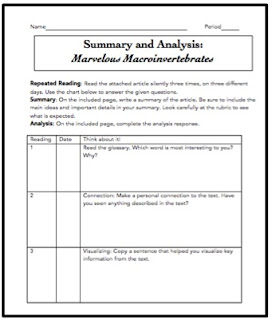 When I taught fourth grade, I spent years devising meaningful homework assignments with vocabulary, fluency practice, and writing. (You can find the January set here.) I loved these packets because they were fun and interesting for kids and adults.
When I taught fourth grade, I spent years devising meaningful homework assignments with vocabulary, fluency practice, and writing. (You can find the January set here.) I loved these packets because they were fun and interesting for kids and adults. The move to sixth grade forced me to think of a new homework routine. What kinds of activities did sixth graders need for ongoing practice and response? I devised the Summary and Analysis packets to answer this question. Each packet contains an article, a summarizing prompt with a rubric, an analysis response question, also with a rubric, and a comprehension quiz.
The move to sixth grade forced me to think of a new homework routine. What kinds of activities did sixth graders need for ongoing practice and response? I devised the Summary and Analysis packets to answer this question. Each packet contains an article, a summarizing prompt with a rubric, an analysis response question, also with a rubric, and a comprehension quiz.I started with the texts. The teacher side of me said, "I need high-quality, well-researched texts related to our science topics, please!" The writer side of me harrumphed, procrastinated, and finally came through.
I assign texts on an alternating week schedule, with assignments due every other Thursday. This gives students plenty of time to work on the assignment both in and out of class. To add to the enjoyment and understanding of the texts, I often show a video or two about the topic--here is my playlist: Article Response Playlist.
Through the months I've tweaked the routine a bit. At first I thought that students would read the texts and generate responses and questions on their own. They found this very challenging, however, which led me to adding some questions to the assignment cover sheets. I've found it interesting how much students resist repeated readings, even with the support that I provide in the classroom. The repeated readings are so important for fluency and for comprehension! I still have trouble convincing students of this, however.
A key component of each packet is the summarizing task. I feel on pretty solid ground as I teach students how to summarize--after all, I've written a book about it--but every year students find new and interesting ways to baffle me. This year, my own son took to writing "about" summaries, which led to some funny home conversations while I was scoring student work! (For more on these, check out this blog post from last year.)
One scaffolding tool that I didn't get to write about in my book is the simple topic/details frame. I've added some of these to the Summary and Analysis packets to help students see how the texts are developed. Very simply, these graphic organizers show the headings in the text and provide space for students to write key ideas. They work well for students and can be provided with varying levels of support.
After students summarize, they respond to a prompt. Most of these are analysis prompts. Some lead to an essay, while others can be answered completely in just a paragraph or two. These analysis prompts are very challenging for sixth graders, many of whom still confuse content with structure. Most of the analysis questions ask students to think about how a piece is written, and sometimes students try to answer by writing about content or rewording their summaries. This shows me that analysis is a skill that needs continued practice and feedback!

A summary and analysis routine is easy to implement with any texts! If you are interested in checking out what I have written, you can find a bundle here.


No comments:
Post a Comment